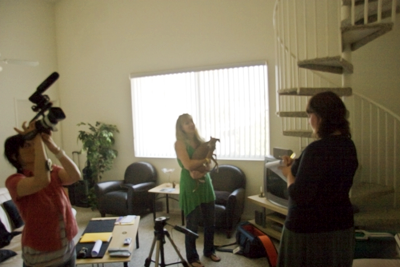Project and
Methods:
Interview:
Teams:
Interviewer, note-taker, videographer
 Miya Osaki and Alyson Markham Shultz assisting in interviewing "Amy" in her home. A team of three is the optimal size when going into a participants space.
Miya Osaki and Alyson Markham Shultz assisting in interviewing "Amy" in her home. A team of three is the optimal size when going into a participants space.In Women Who Play, six of the nine interviews where conducted without a dedicated video team member. Those recordings are all of much lower quality then the three that had a dedicated camera operator. The six interviews without an operator were also made harder by the interviewer or note taker having to step out of their roles to set up the camera. It may be tempting to not video record the interview or to not be concerned with the quality of the recording. Especially if the research has no intention to use interview material in a filmic way. There are three reasons for recording the interviews well. You will always respond to the video differently than the transcript, so both are necessary. You never know what you may wish to do the video at a later time, so having the best quality video is good insurance. Finally, producing a good interview video is within the purview of design, as such it should be done as well as possible.
In Blux, four member teams were sent to each home. The fourth member interviewed the child's parent while the other three interviewed their son. In the current Super Studio year a fourth member of the team took still photographs or ran a second video camera during the interviews. If the fourth team member has a specific task they can be a welcome addition, otherwise the team should be kept small so as to not become to overwhelming to the participants.